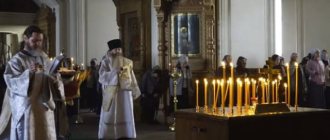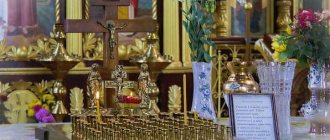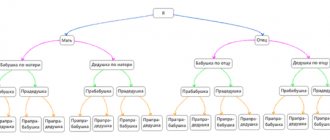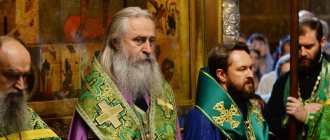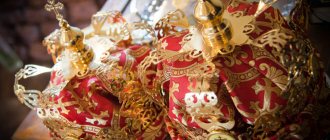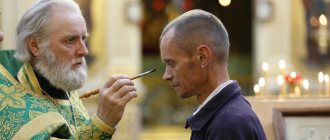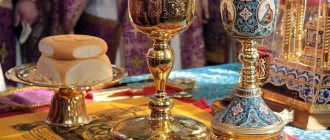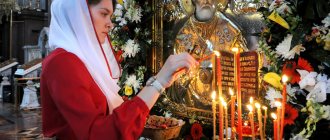How the Divine Liturgy works with explanations
The ritual is performed by the priest with everyone present in the church. Orthodox worship was established by Jesus Christ the day before his death. At the Last Supper, he gave bread and wine from his hands to the apostles, bequeathing them, in remembrance of him, to perform this rite until the end of time: “Whoever eats my Body and drinks my Blood abides in me, and I in him.”
This part of the all-night vigil immerses believers in the church in the atmosphere of the Last Supper. During the service, they should feel the presence of the Holy Spirit in symbolic actions and images. The Holy Spirit, and not earthly man, performs the great Sacrament in the church. The order of reading and singing prayers was established 16 centuries ago. The author of the first liturgy was Saint Basil the Great. John Chrysostom shortened the duration of the service.
John Chrysostom
The solemn ceremony begins after the reading of the hours, which is part of the daily worship in the church. It is divided into Proskomedia, Liturgy of the Catechumens and the Faithful. The early Christians called catechumens people who believed but were not baptized. Faithful - those baptized into the Christian faith, who have not been excommunicated from Communion. The symbolic division has survived to this day.
Preparation in the church for the sacrament (Communion) begins with a symbolic recreation of the image of Jesus Christ and the Church and the moment of his birth. To do this, the priest uses 5 special round loaves (prosphora), baked from 2 halves (a symbol of the union of the human and the divine in Christ).
From the largest prosphora with a cross, the priest cuts out a cube, symbolizing the Lamb (Jesus Christ), and places it in the center of a round dish on a footstool (paten). From the second the priest takes one piece in memory of the Mother of God, from the third - 9, in remembrance of the saints, from the fourth - two, for living parishioners, from the fifth - for the dead.
Pieces of prosphora are laid out in a special order. Parts of the loaves brought by parishioners are also added here. In the sacred vessel, the “blood of Christ” (wine used in church services) is mixed with water, as a reminder of the bloody wound of the crucified Jesus Christ. The priest covers all offerings with cloth embroidered with stars, symbolizing the vault of heaven.
In a prayerful appeal to God, the priest asks him to accept the gifts. In the church they pray for the health and peace of the Orthodox Christians mentioned in the notes. Beginning of the service of the catechumens. The priest, after the deacon’s request for blessing, offers prayerful praise to the Kingdom of God. To which the choir responds: “Amen.”
During this part of the ritual, the service alternates with the reading of litanies and choral singing of psalms. The great litany sounds first. The content of the prayer is a call to church parishioners for peace (peace of mind): one cannot spiritually connect with the Divine essence when passions are raging in the soul. It also contains a request for mercy to the Orthodox Church and parishioners.
A choir of singers sings psalms that describe the life path of Christ until his procession to Golgotha. In song form, the basic position about the essence of Christ is stated: the God-man and man in God. In choral performance, believers listen to the commandments, the fulfillment of which will open the way to the Kingdom of Heaven. Small litanies are heard, reminding believers in the church to struggle with their passions in order to accept Divine truths, containing requests for the forgiveness of sins.
The priests make a small entrance to the altar. The beginning of the preaching life of Jesus Christ is depicted in symbolic form. A burning candle in the hands of a deacon - John the Baptist. Extracts of texts from the collections of the apostles and the Gospel - doctrine. Every gesture and word of the priest is filled with meaning. Before the reading, the priest says, followed by the choir, the Trisagion prayer. The priest takes his place on the pulpit. The deacon calls upon the believers in the church to focus their attention and become imbued with their content during the delivery of apostolic exhortations and evangelical sermons.
The service for the unbaptized ends with a special litany: a request from parishioners for the gift of health and peace. It is traditionally stated that those baptized into Orthodoxy should remain in the church. The service continues for the faithful.
The ritual consists of sequential performance of sacred rites:
- moving the paten with pieces of bread, a vessel with wine to the altar;
- their consecration (Eucharist);
- preparing those present for the sacrament;
- Communion of the faithful;
- statements of thanks for receiving communion and receiving blessings in order to leave the temple.
While the priest is carrying the gifts, the Royal Gates are opened and the choir sings the “Song of the Cherubs,” the main meaning of which is the praise of the Lord. The priests ascend to the altar, which signifies the Great Entrance. The Great Entrance is a symbolic image of Christ’s road to execution, the Resurrection, the Ascension to Heaven, and the meeting with the apostles. Closing the Royal Gate means death. The priest in a petitionary litany begs God to cleanse the parishioners present from their sins so that they can see the consecration of the Gifts. Believers participate in the service, singing the Creed and Our Father.
After the “Creed” comes the sacrament of Communion. The meaning of Communion is forgiveness of offenses to neighbors and sacrifice to God in the form of bloodless gifts.
The consecration of prosphora and wine, that is, transformation into the Flesh and Blood of Christ, occurs after the priest’s prayerful appeal to the Holy Spirit. After the Eucharist, the clergy and choir remember the saints and the Mother of God in prayers of thanksgiving. Parishioners mentally pray for living and deceased Orthodox loved ones.
The priest divides the Lamb into 4 parts:
- "IC" is for sacrifice to God;
- “XC” - for the communion of church servants;
- “NI”, “KA” - for confessed Orthodox Christians.
The first people in the church to receive Communion are the priest and the deacon. The Royal Doors open to the singing of the sacramental canon. A priest comes out with a sacred vessel and a prayer. Believers approach him one by one. After Communion they are given wine to drink, diluted with hot water. Then the minister climbs to the altar and, reading a prayer, drops pieces of bread into the vessel, intended to commemorate healthy and deceased Orthodox Christians. The service ends with the Dismissal, after which the parishioners kiss the priest’s cross and leave the church.
Great Litany
Deacon: Let us pray to the Lord in peace.
Chorus: Lord, have mercy.
Let us pray to the Lord for heavenly peace and the salvation of our souls.
Let us pray to the Lord for the peace of the whole world, the prosperity of God’s holy churches and the unity of all.
Let us pray to the Lord for this holy temple and for those who enter it with faith, reverence and fear of God.
Let us pray to the Lord for this city, every city, country, and those who live in them by faith.
Let us pray to the Lord for the goodness of the air, an abundance of earthly fruits, and times of peace.
Let us pray to the Lord for those who are sailing, traveling, the sick, the suffering, the captives, and for their salvation.
Let us pray to the Lord for deliverance from all sorrow, anger and need.
Intercede, save, have mercy and preserve us, O God, by Your grace.
Our Most Holy, Most Pure, Most Blessed, Glorious Lady Theotokos and Ever-Virgin Mary, with all the saints, having commemorated ourselves and each other and our whole life, let us give over to Christ our God.
Choir: To you, Lord.
Priest: For all glory, honor and worship is due to You, to the Father and the Son and the Holy Spirit, now and ever and unto ages of ages.
Chorus: Amen.
Small Litany
Deacon: Let us pray again and again in peace to the Lord.
Chorus: Lord, have mercy.
Deacon: Intercede, save, have mercy and preserve us, O God, by Your grace.
Let us commemorate our most holy, most pure, most blessed, glorious Lady Theotokos and Ever-Virgin Mary, with all the saints, for ourselves, and for each other, and for our whole life to Christ our God.
Choir: To you, Lord.
Priest: For Thine is the dominion, and Thine is the kingdom, and the power, and the glory, of the Father, and of the Son, and of the Holy Spirit, now and ever, and unto ages of ages.
Chorus: Amen.
Basil the Great
The Liturgy of Basil the Great is served on the first 5 Sundays of Great Lent, on Maundy Thursday and Holy Saturday. The service lasts longer: the texts of the prayers are longer, the melodies are longer. Instead of the joyful “Song of the Cherubim”, the choir sings “... Thy secret supper...”, “... Let all flesh be silent...”.
Presanctified
The Liturgy of the Presanctified Gifts is a divine service on days when one is supposed to fast:
- on Wednesday;
- Friday;
- all days of Great Lent.
The service begins with Great Vespers. After the reading of Psalm 103 and the proclamation of the great litany, the Full Liturgy begins.
Short story
Historically, the vigil dates back to the night services of the first Christians, widespread from the 1st century. Subsequently, the tradition of performing special prayers at night was preserved mostly in monastic monasteries. Some of them, for example, the so-called “Unsleeping” monastery (from the 4th-5th centuries), founded by St. Alexander, generally tried to perform services continuously, in fulfillment of the commandment of St. Paul “pray without ceasing” (1 Thess. 5:17).
Useful materials
Many holy fathers especially advised the faithful to be diligent in night prayer.
St. John Chrysostom writes: “Bend your knees, sigh, pray to your Lord to be merciful to you; He especially bows (to mercy) with night prayers, when you make the time of rest a time of weeping.” And St. Isaac the Syrian states: “Let every prayer that we perform at night be more honorable in your eyes than all the deeds of the day.”
It so happened that these advices were carried out especially zealously by the monks of the monastery of St. Savva the Sanctified (from the 6th century). According to the Rules of the monastery, they spent the entire week in solitary silence, only converging on the eve of the holidays for general church prayer. The night vigil was for them spiritual consolation, reinforcement among their exploits. Thus a following was gradually formed, which then, together with the Rule of St. Savva, also called Jerusalem (after the location of the monastery), passed to Rus'. But unlike Byzantium, vigils began to be served in parish churches as well.
Gradually, a generally accepted opinion developed about the all-night vigil as one of the main services required for preparation for Communion.
1
November
1893
St. Theophan the Recluse wrote, answering a question from one of the laity about the procedure for preparing for Communion: “It is possible to attend church at Vespers, All-Night Vigil or Matins and then take Communion at Mass. And other days of fasting you can replace all services with bows with the Jesus Prayer.”
Until the middle of the 17th century. The vigil was carried out according to the Charter of St. Savva. Then, after the liturgical reform of Patriarch Nikon, the service gradually decreased, now its duration is only 2-3 hours.
Charter of the All-Night Vigil for the choir
The vigil is one of the most complex services in its structure with a variety of liturgical material. At the same time, the choir plays a special role in the service, performing its most important chants.
When the vigil was finally established in the Russian Church, by the beginning of the 16th century. special books for the choir appear - Singing Practices, containing chants of the daily cycle, liturgy, all-night vigil. They are arranged in order of service. Initially, Obikhody presented the chants in the so-called “hook” notation; in their newest editions, the text of the chant usually follows, followed by the same text, set to notes more familiar to modern people.
In addition, there are a number of manuals for the choir dedicated to the all-night vigil. They are especially popular among students of theological schools - seminaries, regency courses. They may be:
- complete sequence, according to which one can see the general scheme, order of service; as a rule, the texts of prayers, psalms, litanies are given here, but there are also liturgical instructions for those singing;
- notes of the most important chants, arranged in order of the vigil;
- finally, there are manuals that combine both approaches; here is placed both the sequence of the all-night vigil itself and the notes and chants; As a rule, one chant can be presented in different versions, set to music by different authors. Such manuals are closer to the liturgical book “Obikhod” itself.
Where can I find the flowchart?
This question is usually quite relevant for novice regents. When since the 1990s. a revival of spiritual life began, many choir leaders of newly opened churches drew a short order of worship by hand on a sheet of cardboard in order to see the participation of the choir at one time or another. Nowadays, similar plans for vigils (and other services) are often posted on church websites and Orthodox Internet portals. They can also be seen as part of various kinds of aids for the choir.
The vigil, which originated among monks, is now an integral part of the spiritual life of the laity. This is a special service that takes you away from the bustle of life on the eve of Sunday, dedicated, according to the commandment, to the Lord.
Natalia Sazonova
Features of the service for the Presentation of the Lord
This is a special holiday that is considered great. He is classified, however, as one of the Theotokos, and not “of the Lord,” that is, dedicated to Christ. The All-Night Vigil of the Presentation has some peculiarities.
Commitment time
The holiday is celebrated on February 15, so sometimes it falls during the preparation for Lent, and sometimes on its first day, Monday (not later).
Holiday, Sunday
If this happens, the service for the holiday is performed the day before, on Forgiveness Sunday. In this case (as in general, if Candlemas falls on a Sunday), the hymns of the Resurrection of Christ are sung along with the holiday ones.
Preparing for Lent
If the Presentation is celebrated during the days of preparation for Great Lent, when penitential chants are already sung, they are also performed along with the festive ones.
Interesting fact
But if the holiday falls on Meat Eating (preceding Maslenitsa) Parent's Saturday, then the service for the deceased takes place a week earlier. There is also a practice of moving this service to Thursday of Meat Week.
Holiday readings
Proverbs, passages from the Old Testament, read at Candlemas, are dedicated to the Mother of God. This
- fragments of the books of Exodus, Leviticus about the firstborn, dedicated to God;
- Isaiah’s prophecy about the burning of a person’s sins by a “burning coal” that touched his lips;
- Chapter 10 of the book of the same prophet is about the appearance of the Lord in Egypt, the fall of idols, which, according to legend, really happened after the Nativity of Christ.
Chants
They are dedicated to Christ, the Mother of God, and also rights. Simeon the God-Receiver.
The troparion of the holiday sounds like this: “Rejoice, Blessed Virgin Mary, for from You has risen the Sun of Truth, Christ our God, enlightening those who are in darkness: rejoice and you, the righteous elder, have been received into the arms of the Liberator of our souls, who gives us resurrection.”

